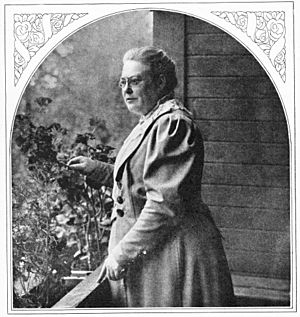Anna Whitlock facts for kids
Quick facts for kids
Anna Whitlock
|
|
|---|---|

Anna Whitlock
|
|
| Born | 13 June 1852 Stockholm
|
| Died | 16 June 1930 (aged 78) Djursholm
|
| Occupation | teacher, journalist |
| Known for | Woman's right activist |
| Notes | |
|
Co-founder and twice chairperson of the National Association for Women's Suffrage.
|
|
Anna Whitlock (born June 13, 1852, died June 16, 1930) was an amazing Swedish woman. She was a teacher who wanted to make schools better, a writer, and a strong supporter of women's rights. She helped start and lead the group that fought for women to have the right to vote in Sweden.
Contents
Early Life and Learning
Anna Whitlock was born in Stockholm, Sweden. Her father was a merchant, but his business failed. Anna's mother, Sophie, then worked hard to support the family. She became a photographer and a translator. It's believed that Anna got her interest in women's issues from her mother.
Anna loved to learn. She studied at the Rossander Course and worked as a teacher. She even worked as a governess in Finland for a few years. Later, she went to a special school for teachers in Stockholm. After graduating in 1875, she traveled to Switzerland, Italy, and France. She studied languages and how to teach. While in Paris, she even wrote for a newspaper called Aftonbladet.
Making Schools Better
In 1878, Anna Whitlock started her own school in Stockholm. She opened it with another famous woman named Ellen Key. The school was first called Stockholms nya samskola. Later, it became known as Whitlockska samskolan. Anna was the principal of this school until 1918.
Her school was very special and new for its time.
- It was one of the first schools in Sweden to be co-educational. This means both boys and girls learned together. This was a big deal because, back then, most schools separated boys and girls, especially after primary school.
- Anna also brought in many new ideas. She started student councils, where students could have a say.
- She also had parent days, where parents could visit the school.
- Students could choose some of their subjects.
- Learning about religion was optional, which was unusual. This made her school popular with families who were not part of the main church.
- She even started vacation camps for students.
Her school was very successful. It got support from the government. It was also allowed to give out official degrees to its students.
Fighting for Women's Rights
Anna Whitlock was a modern thinker with new ideas. She was active in politics and public discussions. She believed strongly in freedom of religion. She even wrote a book about how schools should teach religion.
Anna was a key leader in the movement for women's right to vote in Sweden. This movement is called women's suffrage.
- In 1902, she helped start the National Association for Women's Suffrage. This group worked to get women the right to vote.
- She was the leader of this group twice: from 1903 to 1907 and again from 1911 to 1912.
- Anna wrote the first public message asking Swedish women to join the suffrage movement. She also helped create the rules for the association.
- She was known for being fair and neutral. This was important because the group needed to work with people from different political parties.
In 1905, Anna also started a group called Kvinnornas Andelsförening Svenska Hem. This was a cooperative group that worked to make sure food was good quality. This group still exists today!
Awards and Legacy
In 1918, Anna Whitlock received a special award from the King of Sweden. It was called Illis quorum meruere labores.
After her school closed in 1976, the Anna Whitlock Memorial Fund was created. This fund still gives scholarships to students today.
See also
 In Spanish: Anna Whitlock para niños
In Spanish: Anna Whitlock para niños

